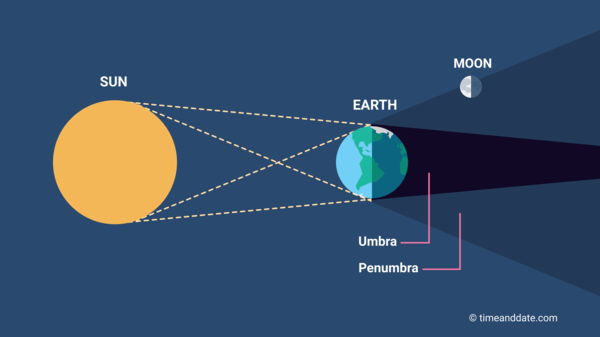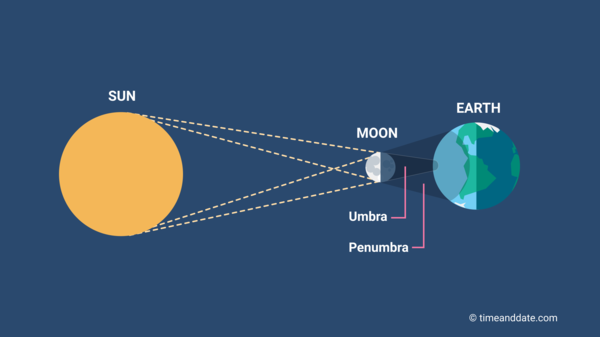Eclipses: What Is the Penumbra?
The penumbra is the lighter outer part of a shadow. The Moon's penumbra causes partial solar eclipses, and the Earth's penumbra is involved in penumbral lunar eclipses.


The penumbra is a lighter type of shadow.
©timeanddate.com
Like any other opaque objects illuminated by a light source, the Moon and the Earth cast shadows into space as they block the sunlight that hits them. Each shadow has 3 different areas: the umbra, the penumbra, and the antumbra.
Penumbra Definition
The penumbra is a half-shadow that occurs when a light source is only partly covered by an object—for example, when the Moon obscures part of the Sun's disk.
The other 2 areas are:
- Umbra – the shadow's dark center portion.
- Antumbra – the lighter part of the shadow that begins where the umbra tapers to a point.
When the Earth enters the Moon's shadow, we see a solar eclipse; when the Moon travels through the Earth's shadow, a lunar eclipse occurs. The type of eclipse depends on the type of shadow that is involved.
Moon's Penumbra Causes Partial Solar Eclipses
If you are standing in the Moon's penumbra and look at the Sun, you will witness a partial solar eclipse.
During some eclipses, the Sun, the Moon, and the Earth do not form a perfectly straight line, so only the penumbra falls on the Earth's surface while the umbra, the shadow's dark center, is cast into space. In that case, the eclipse is classified as a partial solar eclipse, and there are no places on Earth where the Moon obscures the Sun completely.
However, even a total solar eclipse can look like a partial solar eclipse in some locations. The total phase of the eclipse can only be seen from within the Moon's umbra, which only covers a small area on the Earth's surface. Since the Moon's umbra is always surrounded by a penumbra, the eclipse appears partial if you are just outside the spot where the umbra hits. For example, the total solar eclipse on April 8, 2024 appeared as a partial eclipse in most areas in the US, Canada, Mexico, and many other countries.
What is a hybrid solar eclipse?
How Dark Is the Moon's Penumbra?
Within the Moon's penumbra, only part of the Sun's disk is obscured. This means that the penumbra has a considerably lighter shade than the umbra, where the Sun is completely covered. However, the penumbral shadow's light level is not uniform. It is much darker in the areas adjacent to the umbra than at the edges.
This variation is caused by the changing magnitude of the eclipse in different areas within the penumbra. In the penumbra's most central regions, just outside the umbra, the Sun appears nearly completely obscured. This means that only a small portion of the Sun's rays reach us, causing a dark penumbral shadow. On the other hand, in the outskirts of the areas covered by the penumbra, the Moon barely touches the Sun's disk. This means that much more sunlight passes through, making for a very light, and sometimes unnoticeable, shadow.
How Large Is the Moon's Penumbra?


The Moon's umbra and penumbra during a total solar eclipse.
©timeanddate.com
While the Moon's umbra only covers a very small area of Earth at most, the penumbra can envelop whole continents and oceans. This means that partial solar eclipses occur much more often in any one location than total solar eclipses.
For example, at the maximum point of the total solar eclipse on April 8, 2024, the penumbral shadow covered North America, Central America, and most of the Caribbean.
Size Increases With Distance
The reason why the penumbra is so much larger has to do with the distance of the Moon from Earth and the fact that the Moon is smaller than the Sun. With growing distance from the Moon, the diameter of its umbra decreases as the Moon appears to diminish in size. This results in a cone-shaped umbra (see illustration).
Imagine the distance you would have to travel in a spaceship in lunar orbit to reach the umbra's edge from its center—it would be a journey spanning about a thousand miles. In contrast, you typically only have to move about 100 km (60 mi) across the Earth's surface to reach penumbral territory from the umbra's center.
In contrast, the area where the Sun appears partly eclipsed increases in size as you move away from the Moon. From the spaceship hovering just a few miles above the lunar surface, the Moon appears much larger than the Sun, so you would have to travel a relatively short distance to cross the penumbral area, where the Sun appears partly eclipsed. On Earth, however, where the Sun and the Moon look as if they were roughly the same size, that journey would be much longer.
During most eclipses, the region covered by the penumbra is even further enlarged by the fact that in most locations the Sun does not appear in the zenith position (straight above), so its rays hit the Earth's surface at a shallower angle.
Earth's Penumbra Causes Penumbral Lunar Eclipses
Like the Moon, the Earth always casts a penumbra into space. However, you don't need a spaceship to see it. Just look at the Sun during sunrise and sunset. As long as part of it is behind the horizon, you are in the Earth's penumbra. While this happens twice a day in most regions on Earth, penumbral lunar eclipses only occur every so often because they require the Moon to enter the Earth's penumbra.
As some sunlight still reaches all of the Moon's surface directly during penumbral lunar eclipses, they are usually fairly unspectacular. In fact, if the Moon only enters the lighter outer parts of the penumbra, this type of eclipse may even be difficult to distinguish from a normal Full Moon.
The Earth's penumbra is also involved in partial and total lunar eclipses. It covers the Moon's surface before and after the Earth's umbra envelops it. However, this usually goes unnoticed because the phases involving the umbral shadow are much more spectacular.
Penumbra During Planet Transits
During a planet transit of the Sun, Mercury or Venus pass in front of the Sun, as seen from Earth. Because these planets appear much smaller than the Sun, the partial phase, when we travel through the planet's penumbra as the planet crosses the outer edge of the Sun's disk, usually takes only a few minutes.
In contrast, the main phase of the transit, which takes us through the planet's antumbra as it passes in front of the Sun, takes several hours in most cases. The antumbra's diameter increases with growing distance from the object casting the shadow, so it is very wide when it reaches Earth.